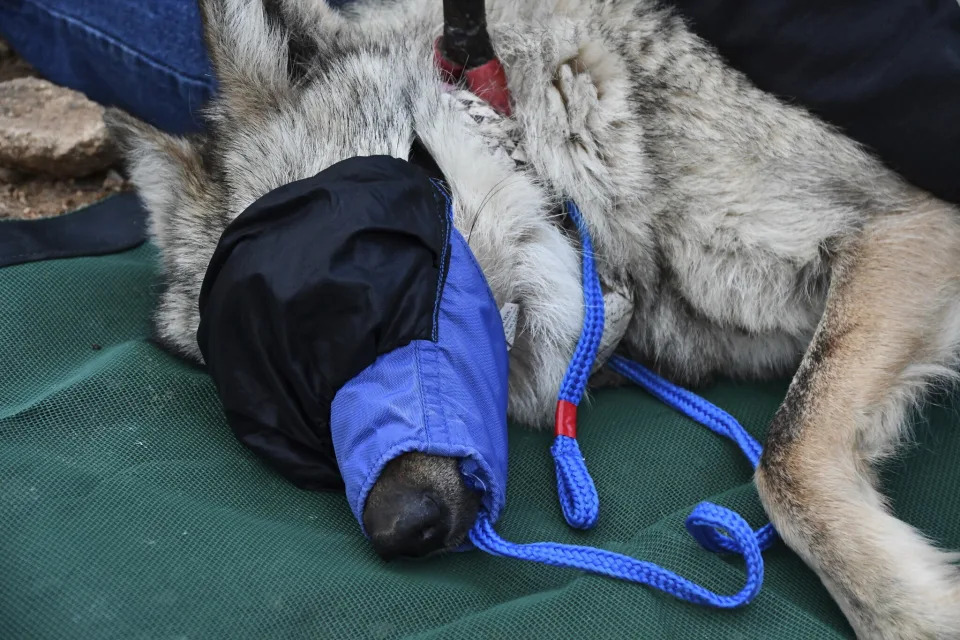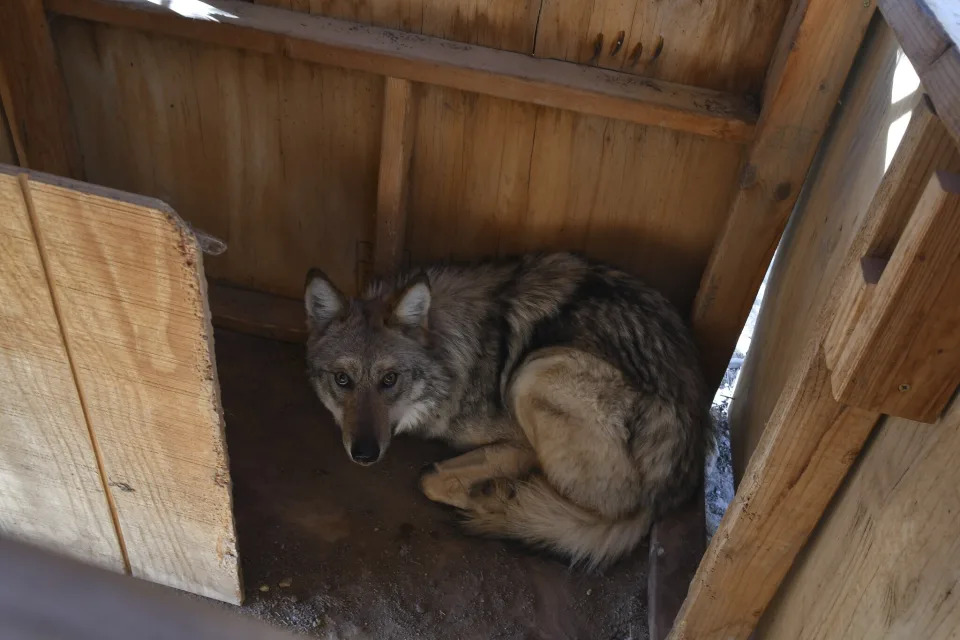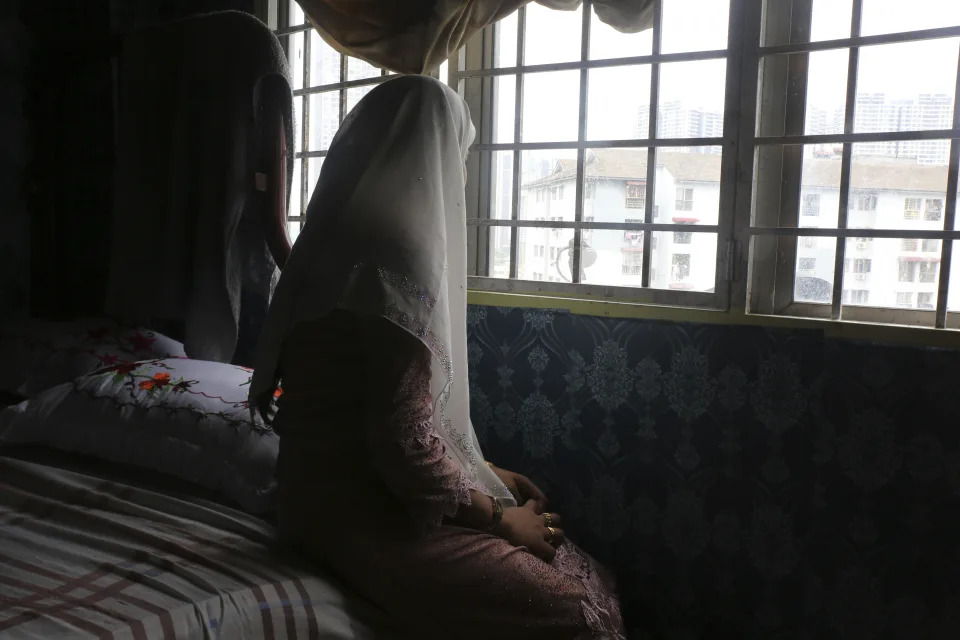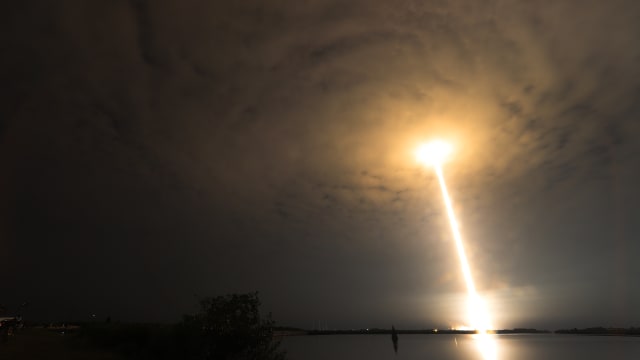JESSE BEDAYN
Updated Tue, December 12, 2023


Gray Wolves-Colorado
In February 2021, Colorado Parks and Wildlife staff tranquilized and placed a GPS collar on male gray wolf 2101 after it had been spotted in north-central Colorado traveling with the female gray wolf 1084 from Wyoming’s Snake River Pack.
DENVER (AP) — Just weeks before the deadline for Colorado to reintroduce gray wolves under a voter-approved initiative, representatives of the cattle industry association are suing state and federal agencies in the hopes of delaying the predators' release.
The Gunnison County Stockgrowers’ Association and Colorado Cattlemen’s Association say in the lawsuit filed Monday that U.S. Fish and Wildlife Services failed to adequately review the effects of reintroducing up to 50 wolves over the next several years.
The carnivores' planned release in Colorado, voted for in a 2020 ballot measure, has already stirred controversy and sharpened divides between rural and urban residents. City dwellers largely voted to reintroduce the apex predators into the rural areas where prey can include livestock that help drive local economies.
Erin Karney, executive vice-president of the Colorado Cattlemen’s Association, said they will also be requesting a temporary restraining order to halt the impending release, which will happen in the coming weeks once the wolves are caught in Oregon.
“A lot of our concerns that we brought up through the wolf management plan hearings were not adequately addressed,” Karney said. “Our members are putting our foot down and saying we can’t rush these processes. We need to take time.”
U.S. Fish and Wildlife Services did perform an environmental review in part on what is called the 10(j) rule, which would permit the killing of wolves in Colorado under certain scenarios — particularly in the defense of livestock — even though the animals are protected as endangered species.
Still, the lawsuit alleges that the review doesn't satisfy federal environmental law and failed to grasp the consequences of wolf reintroduction.
“Impacts of wolf reintroduction... need to be properly reviewed to avoid unintended negative consequences to the natural environment, wildlife, and people of the impacted communities," said Andy Spann, a fifth-generation rancher and president of the Gunnison County Stockgrowers Association, in a statement.
U.S. Fish and Wildlife Services spokesperson Joe Szuszwalak declined to comment, citing ongoing litigation. Colorado Parks and Wildlife spokesperson Travis Duncan said the agency is reviewing the lawsuit and also declined to comment.
An analysis of state and federal data by The Associated Press found that, in 2022, gray wolves attacked domesticated animals hundreds of times across 10 states in the contiguous U.S., including Colorado.
Data showed that attacks killed or injured at least 425 cattle and calves, 313 sheep and lambs, 40 dogs, 10 chickens, five horses and four goats.
While those losses can be devastating to individual ranchers or pet owners, the industry-wide impact is minimal. The number of cattle killed or injured in the documented cases equals 0.002% of herds in the affected states, according to a comparison of depredation data with state livestock inventories.
Ranchers can be reimbursed by the state for confirmed wolf kills, but they say merely financial compensation doesn't assuage the problem of empty-handed customers and the work of installing wolf deterrents.
Gray wolves were exterminated across most of the U.S. by the 1930s under government-sponsored poisoning and trapping campaigns. They received endangered-species protections in 1975, when there were about 1,000 left, in northern Minnesota.
Since then, there has been no turning back for other states where gray wolves have become reestablished.
An estimated 7,500 wolves in about 1,400 packs now roam parts of the contiguous U.S.
___
Bedayn is a corps member for the Associated Press/Report for America Statehouse News Initiative. Report for America is a nonprofit national service program that places journalists in local newsrooms to report on undercovered issues.
Rancher groups sue to delay Colorado wolf reintroduction
On Monday, two rancher associations sued in an attempt to delay the release of gray wolves in Colorado.
US wildlife managers capture wandering Mexican wolf, attempt dating game ahead of breeding season
SUSAN MONTOYA BRYAN
Tue, December 12, 2023



Wandering Wolf
In this Feb. 9, 2023, image provided by the U.S. Fish and Wildlife Service is the female Mexican gray wolf F2754 in a capture box at the agency's wolf management facility at the Sevilleta National Wildlife Refuge in central New Mexico. Federal biologists confirmed Thursday, Nov. 2, 2023, that the wolf has traveled beyond the boundaries of the Mexican gray wolf recovery area for the second time and has been located west of Jemez Springs, New Mexico.
ALBUQUERQUE, N.M. (AP) — A match made in the wilds of New Mexico?
An endangered Mexican wolf captured last weekend after wandering hundreds of miles from Arizona to New Mexico is now being readied for a dating game of sorts as part of federal reintroduction efforts.
But only time will tell whether the U.S. Fish and Wildlife Service can succeed in finding a suitable mate for the female wolf numbered F2754. The newly captured wolf will be offered a choice among two brothers that are also housed at the federal government's wolf management facility in central New Mexico.
“We wanted to bring her in earlier so that she has a longer chance to bond with a mate and then hopefully successfully breed,” said agency spokeswoman Aislinn Maestas. “We’re going to be observing her and waiting to see. Hopefully, she does show interest in one or the other.”
It could be late February or early March before biologists know if their efforts are successful.
It has been 25 years since Mexican gray wolves were first reintroduced into the Southwestern U.S. Through captive breeding and targeted releases, wildlife managers have been able to build up the population of what is the rarest subspecies of gray wolf in North America.
Despite fits and starts, the numbers have trended upward, with last year marking the most Mexican gray wolves documented in Arizona and New Mexico since the start of the program.
Federal and state wildlife managers had been tracking the lone female wolf for months, waiting for an opportunity to capture her again. Her journey began in the mountains of southeastern Arizona and crossed the dusty high desert of central New Mexico before reaching the edge of Valles Caldera National Preserve.
She spent weeks moving between the preserve and the San Pedro Mountains. After showing no signs of returning to the wolf recovery area, officials decided to capture her before the start of the breeding season.
Their opportunity came Saturday near the rural community of Coyote, New Mexico. A helicopter crew working with the New Mexico Game and Fish Department shot her with a tranquilizer dart and then readied her for the trip south to the Sevilleta Wolf Management Facility.
It was about the well-being of the wolf, said Brady McGee, the Mexican wolf recovery coordinator.
“Dispersal events like this are often in search of a mate. As there are no other known wolves in the area, she was unlikely to be successful and risked being mistaken for a coyote and shot,” he said in a statement.
Officials said the goal is that the match-making efforts net pups in the spring and more wolves can be released to boost the wild population.
The recovery area spanning Arizona and New Mexico is currently home to more than 240 of the endangered predators. There also is a small population in Mexico.
Environmentalists had pushed federal managers to let the solo female wolf be, pointing out that previous efforts to relocate her were unsuccessful following her first attempt to head northward last winter. They also pointed out that the wolf’s movements were evidence that the recovery boundaries are insufficient to meet the needs of the expanding population.
“I think what we can say is that we know wolves are driven towards dispersing as a way towards mating with non-related wolves. In the case of Mexican wolves, those unrelated mates are increasingly hard to come by because of the level of inbreeding in the population and the narrow band of Arizona and New Mexico where wolves are allowed to be,” said Greta Anderson, deputy director of the Western Watersheds Project.
Ranchers in New Mexico and Arizona have long complained that wolves are responsible for dozens of livestock deaths every year and remain concerned about any expansion of the wolves’ range. Rural residents in Colorado are joining them as officials plan to release gray wolves there in the coming weeks.

FORT COLLINS, Colo. — Two Colorado ranching organizations have filed a complaint against state and federal agencies requesting the reintroduction of wolves into the state be delayed.
The lawsuit filed Monday by the Colorado Cattlemen’s Association and Gunnison County Stockgrowers Association comes just weeks before state officials were to release up to 10 gray wolves under a 2020 state law. The suit names the U.S. Fish and Wildlife Service and Colorado Parks and Wildlife as defendants, according to a Tuesday news release from the CCA, which represents more than 6,000 producers and landowners.
The two organizations believe Colorado Parks and Wildlife and the U.S. Fish and Wildlife Service violated the National Environmental Policy Act by not conducting a thorough environmental impact statement and that reintroduction should be delayed until that process is complete.
Both organizations have opposed wolf introduction since voters narrowly passed the ballot initiative to begin reintroducing wolves by the end of 2023. Colorado Parks and Wildlife is in the process of capturing wolves in northeast Oregon to serve as initial release animals.
The complaint is the first legal action taken since the U.S. Fish and Wildlife Service's 10(j) rule under the Endangered Species Act went into effect in Colorado on Dec. 8. The rule designates gray wolves in Colorado as experimental and provides state officials and livestock producers more management flexibility of wolves, including the killing wolves in situations where wolves are caught in the act of killing livestock or where chronic depredation is occurring.
Colorado to release gray wolves: Here's when, where and why.
Controversial release plan has divided communities
The plan to release the wolves has divided urban and rural communities.
Many ranchers and farmers noted the risks wolves could pose to humans and livestock. The state's wolf reintroduction plan was largely supported by urban residents and supporters of the plan say wolves are a natural part of the ecosystem in the West.
State officials said they hope that the gradual release of the wolves captured from Oregon would eventually create self-sustaining packs of 150 to 200 animals. In the 1940s, the wolf population in Colorado was nearly eradicated and now the state is only home to a small number of wild wolves.
Will this legal action delay the release of wolves in Colorado?
The key element to Monday's complaint is whether the ruling judge will allow for the continuation of wolf reintroduction into Colorado while the complaint is being ruled on. The legal process to determine a ruling regarding the complaint can take several years.
Andy Spann, a fifth-generation rancher from Gunnison and president of the Gunnison County Stockgrowers Association, said in the release that the organizations' concerns during the nearly three-year process to create a state wolf recovery plan were not adequately addressed.
"Impacts of wolf reintroduction, as would any other action of this magnitude, need to be properly reviewed to avoid unintended negative consequences to the natural environment, wildlife, and people of the impacted communities," he said.
Michael Saul, Rockies and Plains Program Director at Defenders of Wildlife, said in a news release the organization will work to see wolf reintroduction efforts continue. Defenders was one of several wildlife advocacy organizations to speak out against the lawsuit.
"Defenders is sorely disappointed by this transparent, 11th-hour attempt to delay efforts to bring wolves and their ecological benefits back to Colorado," he said. "Coloradans voted, the state worked extensively with ranchers and conservationists alike to prepare, and the lawful path forward is clear. Defenders stands poised to respond to ensure this last-minute maneuver will not thwart the historic return of the wolf."
Will wolverines go extinct? US offers new protections as climate change closes in
Colorado was under pressure to get environmental impact statement completed
Colorado paid the U.S. Fish and Wildlife Service $1 million to complete the environmental impact statement. The state faced time constraints to get the statement completed in time for the 10(j) rule to go into effect before wolves were reintroduced.
Colorado Parks and Wildlife Director Jeff Davis previously praised the expedience in which the statement process was concluded, about half the time it normally takes.
"This demonstrates a sincere and effective commitment by the U.S. Fish and Wildlife Service to accomplish this task on a very accelerated timeline," Davis said in a previous release. "National Environmental Policy Act work typically takes two to three years and it was accomplished in a little over a year-and-a-half."
Contributing: Trevor Hughes, USA TODAY
This article originally appeared on Fort Collins Coloradoan: Colorado ranching groups file lawsuit to delay wolf reintroduction
Miles Blumhardt, USA TODAY NETWORK
Tue, December 12, 2023
Tara Suter
Tue, December 12, 2023

The Colorado cattle industry is suing over the reintroduction of gray wolves into the Centennial State.
The Colorado Cattlemen’s Association (CCA) and the Gunnison County Stockgrowers Association (GCSA) are taking legal action against the U.S. Fish and Wildlife Service (FWS) and Colorado Parks and Wildlife (CPW) “regarding the pending release of gray wolves in Colorado,” according to a blog post on the lawsuit from the CCA and GCSA, filed a couple of weeks before the wolves’ reintroduction as a result of a voter-approved initiative.
“The decision to pursue legal action comes after extensive discussion and consultation with CCA and GCSA members, who are deeply committed to the prosperity of Colorado’s agricultural industry and the well-being of their livestock,” reads the Monday blog post on the lawsuit from the CCA and GCSA.
“Both organizations, CCA and GCSA, have opposed wolf introduction since it was a proposed ballot initiative and were involved in every step of the process,” the blog post continues. “CCA and GCSA actively participated in developing the Colorado Parks and Wildlife Commission’s Wolf Management Plan as members expressed detailed oral and written concerns regarding the scope of impacts associated with the potential release.”
Voters in Colorado approved a ballot measure in 2020 to allow the reintroduction of the carnivores. Despite the measure’s success, there has been contention around the wolves’ return to the Mountain West state, with those living in cities mostly voting in favor of doing so despite the issue not affecting them as much as those living in rural areas.
“We regard this path of litigation not out of a desire for conflict, but rather as a testament to our unwavering commitment to supporting Colorado’s agriculture community and producers of the western slope,” Robert Farnam, CCA president, said in a statement.
A spokesperson for the FWS told The Hill the agency is not able to comment “due to the nature of ongoing litigation.” CPW said in an emailed statement that it is also reviewing the lawsuit.
The Associated Press contributed.
Updated: 3:30 p.m.
Brooke Baitinger
Tue, December 12, 2023

An endangered Mexican gray wolf known for wandering across the southern U.S. was captured after she roamed where wildlife officials wish she wouldn’t — for the second time.
The New Mexico Department of Game and Fish used a helicopter to find and capture female wolf 2754 — known as Asha among conservationists — in hopes of breeding her, according to a U.S. Fish and Wildlife Service news release on Dec. 11.
In January, Asha ventured away from the pack she was born into and outside the agency’s Mexican Wolf Experimental Population Area north of Interstate 40, wandering 500 miles north into the southern Rocky Mountains of New Mexico, McClatchy News previously reported.
Officials captured her later that month near Taos and held her at the agency’s Sevilleta wolf management zone outside Socorro, where officials tried — and failed — to breed her, McClatchy News reported. When Asha didn’t breed with the male selected for her, officials released her in June back into the Arizona wilderness where she was born in 2021.
Just as she’d done in January, Asha left the agency’s wolf management zone in late October, officials said.
This time, she “spent several weeks moving between the San Pedro Mountains and the Valles Caldera National Preserve” and showed “no signs of returning” to the management area, officials said.
So wildlife officials decided to capture Asha before breeding season started, and they managed to do exactly that Dec. 9, officials said.
“Our decision to capture F2754 was made out of concern for her safety and wellbeing,” Brady McGee said in the release. McGee is the agency’s Mexican wolf recovery coordinator.
“Dispersal events like this are often in search of a mate. As there are no other known wolves in the area, she was unlikely to be successful, and risked being mistaken for a coyote and shot.”
Officials paired her with a “carefully selected mate” and hope she’ll breed in captivity this time, the release said.
“The best outcome for her is to be released back into the wild, where she and her offspring can contribute to Mexican wolf recovery,” McGee said.
Wolf conservationists said Asha’s second capture disappointed them.
“Asha’s capture is a frustrating, but not permanent pause in her journey,” the Wolf Conservation Center said on Facebook. “Despite physical and political barriers, she’s continued to show the nation that her home exists north of I-40, not in captivity or in the arbitrary confines of the Mexican Wolf Experimental Population Area. When we finally stop trying to control wolves, we’ll realize that ‘recovery’ is much easier to achieve.”
Several people said in the comments section they were praying for Asha’s safety.
“No animal will ever see or feel arbitrary borders because in their free spirits the world is their playground,” someone said.
Defenders of Wildlife, a nonprofit group dedicated to wildlife conservation, believes the attempt to breed Asha will limit her movement once she’s released back into the wild with pups, the group told McClatchy News in an emailed statement.
“This wolf posed no threat to anyone,” said Bryan Bird, the organization’s Southwest program director. “She should be allowed to roam, to seek her own destiny. Wolves will naturally repopulate their historic range and we should be facilitating that instinct and preparing the way with facts and common-sense activities.”
Wandering Mexican gray wolf released back into Arizona wilderness ‘where she belongs’
Beloved gray wolf matriarch dies, California zoo says. ‘Huge gap in our hearts’
‘Legendary’ wolf that parented 40 pups reappears in Arizona 2 years after vanishing





















